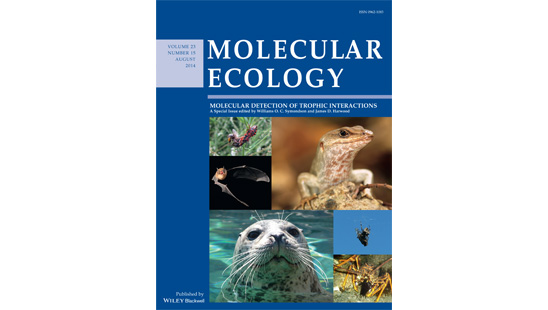Harwood lab has three papers published in special edition of academic journal
Harwood lab has three papers published in special edition of academic journal

Scientists in a University of Kentucky insect ecology lab recently had three papers published in a special edition of the academic journal Molecular Ecology.
The edition, focused on scientists’ efforts to unravel food webs in nature, was a result of an international meeting hosted by UK’s Department of Entomology and College of Agriculture Food and Environment in 2013.
“A lot has changed in this area of study since the first international meeting in Austria seven years ago, including the ability to use next generation sequencing to rapidly identify the unique molecular signatures of prey present in predators’ guts,” said Harwood, UK associate professor in entomology, who is internationally known for his work in molecular gut-content analysis and insect food webs. “Articles in the journal cover diverse ecological studies and techniques including predation, parasitism and herbivory in land and water ecosystems.”
The special issue consists of 27 scientific articles. Harwood and William Symondson from Cardiff University in Wales wrote the journal’s introduction. Harwood’s former lab members Jason Schmidt, a post-doctoral scholar, and Kelton Welch, a doctoral student, were principal authors on the other two articles.
Schmidt’s research was in collaboration with Mark Williams, UK associate professor of horticulture, and Ric Bessin, UK extension professor of entomology. The research investigated predator and prey relationships in organic agriculture. Schmidt particularly focused on identifying natural enemies of the squash bug, a major pest of organic squash and pumpkins in the United States. Schmidt tested 640 potential predators through molecular gut content analysis of each predator and squash bug. He found that 11 percent of the predators tested preyed on the squash bug but their predation varied over the season between different groups of predators. Data from his research can help producers more effectively use beneficial insects to control squash bug populations and rely less on organic insecticides that are expensive, have limited efficacy and negatively impact pollinators and natural enemies.
Welch’s study tests two statistical approaches to advance molecular gut content analysis. His study tested these approaches on orb-weaving and sheet-weaving spiders and their common prey, springtails. He found that orb-weaving spiders consume more springtails compared to sheet-weavers, even though springtails are not as common in their microhabitat. He was able to link the orb-weaving spiders’ ability to feed on more springtails to their web structure.
The journal is available online at http://onlinelibrary.wiley.com/doi/10.1111/mec.12831/abstract.
Entomology Horticulture Research

